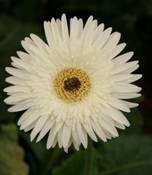
Fig 1.1
Crop: Gerbera
Scientific name :
Common / Local Name :

Fig 1.2
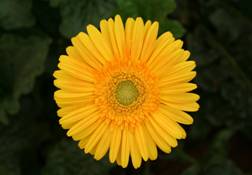
Fig 1.2
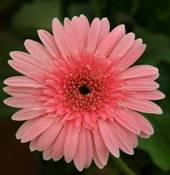
Fig 1.3
Gerbera (Gerbera jamesonii) also known as Baberton Daisy or African daisy is herbaceous dwarf perennial named after Gerber, a German naturalist. The plants are stem less, dwarf 30 ‚Ä?40 cm tall and hairy. It belongs to the family composite. The flowers are very popular for home gardening as well as commercial purpose.
Gerberas need a porous well-drained soil with plenty of Organic matter. Soil pH should be between 5.5 ‚Ä?6.5 and should be maintained at this level to get maximum efficiency in absorption of nutrients.
Before planting the soil may be disinfected to control the Fungus menance in Gerbera by one of the following ways.
Cover the soil with plastic for 6 ‚Ä?8 weeks to destroy the fungi.
Use 7.5 to 10 litre Formalin diluted in 10 times for 100 sq. mt. The beds may be drenched and covered with plastic for 7 days. The soil may then be flushed with 100 litre water to wash out any residues.
Gerberas may be grown on raised beds having 1.5 ft x 2 ft size or in pots. The plant-to-plant spacing of 30 and row-to-row 35 cm is ideal. Generally two rows are maintained on 1 bed. Gravel of sand may be added at the bottom for better drainage. Organic manure should be added to improve the soil texture and provide nutrients gradually. 2.50 kg or single super phosphate and 0.50 kg Magnesium sulphate for 100 sq ft may be added for improving the root establishment and over growth.

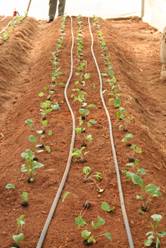
 
Plants raised by division of suckers from the mother plants are ideal. Suckers should have a few well-developed leaves and roots. When planting the crown of the plant should be 1 ‚Ä?2 cm above soil level.
Tissue culture plants are easily available nowadays and easy to grow. The soil around the plants may be loosened afterevery fortnight for aeration.
If Gerbera‚Äôs are grown in Shade house/Green house care should be taken to ensure the height is a min ‚Ä?5- 6.5 mt for proper air circulation. The Shade house should be covered with polythene sheets with sufficient ventilation on top and sides. This will help in protection during monsoon as well. In order to control light intensity¬†¬† and Midday heat white shad net may be used which is fitted in such a manner that it is adjustable for use as and when required.
Ideal temperature for flower initiation is 23o C. When temperature goes above 35o C and below 12o C the flowering will be disturbed. Optimum humidity inside a shade house should be 70 ‚Ä?75%.
Gerbera‚Äôs require 80 ‚Ä?90% humidity immediately after planting. This is possible by irrigation with overhead irrigation system or spraying the same until a month or so. This helps in uniform root development. Thereafter gradually change the drip irrigation. Generally 1 drip per plant is required. If hard watering is adopted then a jerry can may be used. The quantity of water required for a plant varies from season to season. Watering should be completed before 12 noon. The relative humidity of the air should not exceed 90 ‚Ä?92% as it cause deformity of flowers. Soil may always be moist and never soggy or dry.
Besides a good basic dose of organic manure at planting time a fertilizer dose made up of 1:1:1 NPK may be applied upto 3 months @ 4/gm/plant for development of vegetative growth. Thereafter 2:1:4 NPK (eg. 15:8:35) @ 0.4 gms/plant may be applied on alternate days for optimum results. In addition micronutrients may be used fortnightly or as per the deficiency symptoms.
Mites, Thrips, leaf Miner, Aphids are some of the pests that attack Gerbera plants and crown rot, Root rot, Fusarium, Root knot Nematode and Botrytis are some of the Diseases.
- Aphids:
Cause deformed leaves, excrete some substance on which fungus develops.
- Use Chloropyriphor 1 ml / litre of water.
- Greenhouse Whitefly:
Occurs when climate is hot & dry, cause damage to leaves.
- Use Nemzol or Endosulphan 2 ml / 1 litre of water.
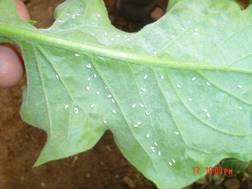
- Leaf Miner:
White specks on leaves caused by flies. White tunnels in leaves caused by larvae, which stays in soil.
- Use Chloropyriphos 1 ml / 1 litre of water.
-
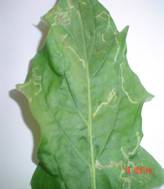
- Mites:
Older leaves are curled up. Younger ones being deformed & leathery, deformed flowers or if petals are missing.
- Use wettable Sulphur 1.5 gm/ litre of water.
- Thrips:
Causes white specks or strips on ray florets; flower heads may be deformed. Silvery, grayish spots on the leaves, Brown spots on leaf petioles / midvein.
- Use Nuvacron 2 ml in 1 litre of water.
-
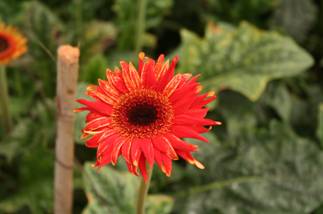
- Crown Rot:
Caused by Phytophthora crytogea results in wilting disease of Gerbera, Crown of the plant becomes black.
- Use Trichoderma Bio Fungicide 4 gms or Toprim m 2 gms / litre of water.
- Root rot:
Caused by Pythium. Root skin is easily removed.
- Use Benomyl 3 gm or Baviatin 2 gm / litre of water.
- Fusarium:
vessels are black.
- Use Tricohoderma Bio Fungicide 4 gms or Toprin M-2 gms.
- Root knot Nematode:
Yellowing of leaves; nodules on roots.
- Use Neem cake 30-40 gms/plant or Furadon 10 gms / plant.
Gerbera is a 24 ‚Ä?30 month crop. The first flowers are produced 7 ‚Ä?8 weeks after plantation. The flowers are harvested when 2 ‚Ä?3 whorls of stamens have entirely been developed. This will help in longer vase lift. The flowers need to be plucked from the plant and not cut. Harvesting is preferably done in the mornings or late evenings during the day. Flowers need to be immersed in water immediately.
Input availability |
Address/Contact details |
| Tissue culture plants | KF bioplants, Pune, Florance Flora, Bangalore, SPIC, Coimbatore |
Fertilizers |
For detailed list kindly click here |
Pesticides |
For detailed list kindly click here |
| Machineries | Department of Agriculture, Panaji, Goa tractors and Tillers, Mapusa |
|